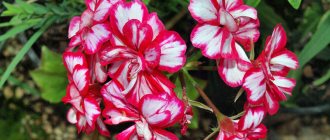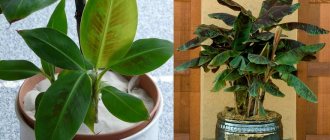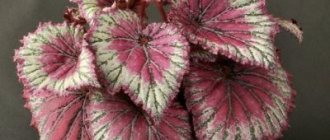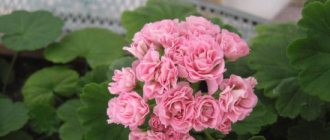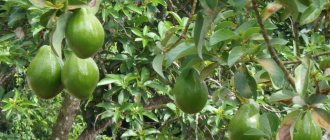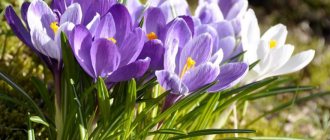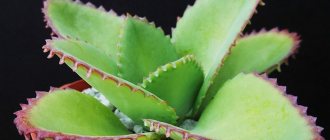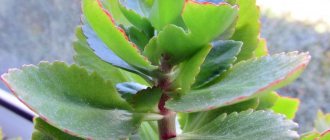In courtyard front gardens, on window sills, balconies and even in city flower beds, with the onset of summer, you can see brightly blooming bushes of pelargonium, popularly called geranium.
Thanks to their unpretentiousness and ease of care, pelargoniums enjoy the well-deserved love of gardeners. But few people, unfortunately, suspect that among the family of real “Cinderellas” there are also “queens”. Royal pelargonium, Pelargonium grandiflorum or regale, differs from its closest relatives in its most magnificent flowering and somewhat more whimsical character.
Features of large-flowered pelargonium
As befits a plant with such a big name, at home, royal pelargonium, in the photo, is more demanding of care than common varieties of zonal geranium, and it does not bloom for such a long time. But, having just once seen huge flowers of various shapes and colors collected in umbrella inflorescences, it is impossible not to be eager to grow an equally beautiful plant on your windowsill.
Royal pelargonium, reaching a height of 30–60 cm, differs from other varieties:
- folded leaves with a dense leaf blade that is rough to the touch and jagged edges;
- large, up to 7 cm in diameter, simple and double flowers.
The decorative effect of the inflorescences is added by the multi-colored coloring of the petals, but while the flowering period of zonal geraniums ends in autumn, the last inflorescences of royal pelargonium wither in the second half of summer.
As a result, you can admire the caps of airy bright flowers for 3 to 5 months, and it is doubly offensive if buds never appear on the bush in the spring.
Features of the view
Many inexperienced gardeners confuse pelargonium with geranium. However, if you look closely, you can find quite a lot of differences. The most important difference is the shape of the flower. In geranium it is correct. But pelargonium does not, the bud is somewhat similar to the beak of a stork (which is where the name of the plant itself comes from).
Royal pelargonium was first described at the beginning of the twentieth century - in 1901. This species was the result of long-term crossing work. This was done by botanist Liberty Hyde Bailey. The scientist also found out that most of these flowers grow in England, the Netherlands and Germany. This plant is considered aristocratic not only because of its name, but also because of its whimsical care. Not all flower growers have the patience to care for the “Queen”.
The following factors can be attributed to the peculiarities of cultivation::
- short flowering period;
- any, even the most insignificant, mistake during cultivation can lead to the absence of buds;
- outdoors, the plant may die; it is better not to expose it to the street;
- It is very difficult to propagate the royal flower.
The leaf plates have a rough surface and pointed edges. The buds can be either simple or double. Another feature of the petals is the presence of a spot in the center on each of them . It is also worth mentioning that the shoots begin to become stiff at the base.
Reference . The royal beauty can reach 1.5 meters in height. However, there is no point in bringing the flower to such a size at home, since the buds are placed at the very tops of the shoots. The optimal size is a height of 40-60 centimeters - this way the bush will look chic, but at the same time compact.
Why doesn't royal pelargonium bloom?
Having planted a young plant in the ground, amateur gardeners look forward to the appearance of spectacular inflorescences above the greenery, but sometimes they have to face disappointment. Instead of flowers, large-flowered geranium produces only greenery, and the rapidly growing shoots soon lose their appearance and become elongated. What mistakes were made when caring for royal pelargonium at home, and why, as in the photo, was the plant left with almost no flowers?
Indeed, if pelargonium does not bloom in due time, this may indicate:
- about incorrectly selected temperature conditions or lack of lighting;
- that the plant is planted in a pot that is too large or receives fertilizers of an inharmonious composition;
- about untimely transplantation;
- about illiterate pruning or its complete absence.
How to care for royal pelargonium so that the plant blooms regularly, is healthy and does not lose its decorative appearance all year round?
The most common types: description and photo
This genus of plants of the geranium family has about 250 species, among which royal pelargonium stands out for its most lush inflorescences, but at the same time for its more whimsical disposition. This attractive variety has a bush height of up to 50 cm.
Double or single flowers have wavy or grooved petals. They are distinguished by the presence of spots or stripes of a different shade. There are practically no single-color indoor royal pelargoniums.
Carisbrooke
Light pink flowers with a marbled pattern of a darker shade located closer to the base. The spots spreading across the petal in uneven strokes add zest to the delicate background tone.
Aristo Schoko
Large inflorescences, with dark petals - so red that they are almost black. The border is two shades lighter. Rarely found in stores, and therefore highly prized by collectors.
Mona Lisa
Large white flowers with pink stamens. Wavy petals seem to be dotted with fringe. Sometimes, against a light background, a small pink spot stands out in the middle.
Pink Mikado
The largest inflorescences among royal pelargoniums. They have an even pink tone and a wavy edge. Very soft and airy.
Nellie
Dark red and white petals wavy throughout the plate. At first glance, the color resembles a pansy. Spectacular flowers fully compensate for the quickly woody stem and falling lower leaves.
Roussillon
The color is similar to Aristo Schoko, but the lightening is brighter and is not only on the border, but also from the center of the flower. The shades are predominantly purple. Capricious: growing at home is more difficult than other varieties, and you need to take care of it more carefully, otherwise it will not bloom.
Sally Munro
Blooms several times a season. It is distinguished by large inflorescences with lighter lower petals and upper petals of a rich ruby hue.
This is interesting: there is an opinion that red pelargonium improves health, pink attracts love, and white flowers increase the ability to conceive.
Summer care for royal pelargonium at home
When speaking about the unpretentiousness of pelargoniums, experts of this species are not lying at all.
In order for royal pelargonium to feel comfortable and delight its owners with abundant flowering, the gardener needs to adhere to just a few rules that will lay the foundation for the success of the entire cultivation.
Large-flowered varieties of pelargonium are demanding of lighting and like to be exposed to the brightest sunny windows. Only on the hottest days do plants need darkening to protect them from burns; in other cases, limiting light is a risk:
- stretching and exposing shoots;
- reducing the intensity of flowering;
- dropping buds that have already appeared.
Unlike related varieties, royal pelargonium does not tolerate drafts and cold winds; if such a plant is planted in the garden, it will probably not please you with its inflorescences. Therefore, royal pelargoniums are grown at home, and care in the summer includes protection from drafts. Plants feel great and bloom profusely on glazed sunny terraces and loggias.
If the air is excessively dry in summer, pelargonium can be sprayed with water at room temperature, making sure that wet leaves and inflorescences are not exposed to direct rays of the sun.
Flower growers who are passionate about this spectacular crop need to know that in hot weather the plants are most susceptible to attacks by aphids and other insect pests, which, parasitizing on the stems and leaves, seriously weaken pelargonium. And here is the answer to the question: “Why doesn’t royal pelargonium bloom?” will be obvious.
At the same time, do not forget about watering and fertilizing flower plants. Although pelargonium easily tolerates dry periods and is not too demanding on the composition of the soil, without water and nutrition it will undoubtedly not produce the required number of flowers. In the warm season, large-flowered varieties require especially abundant watering, which is carried out when the top layer of soil dries out a little.
You can prolong flowering and preserve the strength of the plant if you promptly remove dried flower stalks that have lost their decorative effect.
Plant Collectors Data Bank
| Search for plants by name | Nurseries by region | Selling plants | Plant photo galleries |
| Peony photo galleries | Photo galleries of perennials | Photo galleries of flowers | Photo galleries of fruits |
| Photo galleries of shrubs | Photo galleries of irises | Phlox photo galleries | Houseplants |
| Photo galleries of garden flowers | Photo galleries of indoor flowers | ||
Photos of pelargoniums and names of varieties from the collection of A.N. Kostyrina, Bryansk region
Description of the composition of the entire Pelargonium collection by mail
Zonal pelargoniums with double (Double Zonale), semi-double (Semi-Double Zonale) and simple (Single Zonale) flowers get their name due to the concentric zone of a darker color, which is located in the middle of the leaf. They are the most common and are known as "indoor geraniums".
| Pelargonium Sarah Hunt | Pelargonium Warrenorth Pearl | Pelargonium Bold Pixie | Pelargonium Bold Pixie | Pelargonium Sarah Hunt |
Pelargonium Creamery | Pelargonium Ray Bidwell | Pelargonium Pac First Yellow | Pelargonium Pac Blue Wonder | Pelargonium PAC Harmony |
| Pelargonium Warrenorth Pearl | Pelargonium Pac Blue Wonder | Pelargonium Elmsett | Pelargonium Pac Shocking Violet | Pelargonium Bold Sunset |
| Pelargonium Peppermint Twist | Pelargonium Red Explosion | Pelargonium Pac Blue Wonder | Pelargonium High Tor | Pelargonium Tie Die |
| Pelargonium White Butterfly | Pelargonium Jessica | Pelargonium PAC Viva Maria | Pelargonium PAC Viva Maria | Pelargonium Tie Die |
| Pelargonium Magnus | Pelargonium Pac First Yellow | Pelargonium Frou Frou | Pelargonium Tresor | Pelargonium Shimmer |
| Pelargonium Warrenorth Pearl | Pelargonium Abba | Pelargonium Happy of New Life, foliage | Pelargonium Angelique | Pelargonium Regina |
| Pelargonium Frou Frou | Pelargonium Red Explosion | Pelargonium Emperor Nicholas | Pelargonium Odensjo Appolonia | Pelargonium Ainsdale Duke |
Pelargonium Joy | Pelargonium Helen | Pelargonium Red Explosion | Pelargonium Red Explosion | Pelargonium Mr Wren |
Pelargonium Sussex Gem | Pelargonium Emperor Nicholas | Pelargonium Golden Anniversary | Pelargonium Great Bricett, foliage | Pelargonium Americana White Splash |
Pelargonium Emperor Nicholas | Pelargonium Ivory Snow | Pelargonium Minx | Pelargonium Americana White Splash | Pelargonium Kronprinsesse Mary |
| Pelargonium Elmsett | Pelargonium Odensjo Poetry in Motion | Pelargonium Golden Anniversary | Pelargonium Skies of Italy | Pelargonium Peter Read |
| Pelargonium Bills Gem | Pelargonium Elspeth | Pelargonium Laureen Alexandra | Pelargonium Lara Harmony | Pelargonium Alex Kitson |
| Pelargonium Orangesonne | Pelargonium Magnus | Pelargonium Deacon Finale | Pelargonium Sussex Gem | Pelargonium Cupid |
| Pelargonium Jessica | Pelargonium Flirt | Pelargonium Golden Anniversary | Pelargonium Dylan Cherone | Pelargonium Golden Choice |
Pelargonium Kronprinsesse Mary | Pelargonium Lake | Pelargonium PAC Salmon Princess | Pelargonium Wendy Read | Pelargonium Creamery |
| Pelargonium Davina | Pelargonium Elmsett | Pelargonium Dibbinsdale | Pelargonium PAC Flower Fairy Berry | Pelargonium Davina |
| Pelargonium Dovepoint | Pelargonium Elmsett | Pelargonium Warrenorth Platinum | Pelargonium Vina | Pelargonium Kennys Double |
| Pelargonium Dovepoint | Pelargonium Lara Harmony | Pelargonium Odensjo Rodluvan | Pelargonium Tresor | Pelargonium Doods Super Double |
| Pelargonium Golden Choice | Pelargonium Bold Sunset | Pelargonium Warrenorth Carneleon | Pelargonium Shimmer | Pelargonium Brooks Purple |
Pelargonium Warrenorth Kunzite | Pelargonium White Butterfly | Pelargonium Kennys Double | Pelargonium High Tor | Pelargonium Great Bricett |
Pelargonium Carousel | Pelargonium Warrenorth Citrine | Pelargonium Edmund Lachenal | Pelargonium Meadowside Orange | Pelargonium Minx |
| Pelargonium Ibiza | Pelargonium Vectis Embers | Pelargonium PAC Viva Madeleine | Pelargonium Carousel | Pelargonium Minx |
| Pelargonium Mrs. Eve Scott | Pelargonium Brenda Hyatt | Pelargonium Norrland | Pelargonium Natalie | Pelargonium Askola |
| Pelargonium PAC Viva Madeleine | Pelargonium Alex Kitson | Pelargonium Bold Pixie | Pelargonium Mrs. Eve Scott | Pelargonium Creamery |
| Pelargonium PAC Viva Rosita | Pelargonium Video Blush | Pelargonium Helen | Pelargonium Mimi | Pelargonium Jyvaskyla |
| Pelargonium PAC Viva Rosita | Pelargonium Dovedale | Pelargonium ERAs Blodroda | Pelargonium PAC Flower Fairy Velvet | Pelargonium Elnaryds Clarissa |
| Pelargonium Frou Frou | Pelargonium Double Pink Birds Egg | Pelargonium Sunstar Cherry | Pelargonium Norrland | Pelargonium Odensjo Rodluvan |
| Pelargonium Camisole | Pelargonium Edwards Toscana | Pelargonium Happy of New Life | Pelargonium Regina | Pelargonium Warrenorth Thulite |
| Pelargonium Brocade | Pelargonium Pretty Petticoat | Pelargonium Odensjo Hummingbirds Egg Butterfly | Pelargonium Orchid Paloma | Pelargonium Frou Frou |
Pelargonium Frou Frou | Pelargonium Pebbles | Pelargonium Telstar | Pelargonium Baby Brocade | Pelargonium Tamara |
| Pelargonium Golden Choice | Pelargonium PAC Viva Maria |
Features of winter care for large-flowered geraniums
After the luxurious flowers wither, pelargonium should recover, but if you leave it on a warm windowsill until next spring, you may not wait for the next flowering. How to care for pelargonium in autumn and winter? With the onset of autumn, when the temperature drops, caring for royal pelargonium at home changes. For three months the plant is provided with:
- temperature about 12–15 °C;
- rare watering, which only supports the decreased activity of pelargonium;
- sufficient lighting.
Feeding is stopped for the entire wintering period. If all care conditions are met, the plant lays a sufficient number of flower buds and will definitely bloom luxuriously when it emerges from winter torpor.
Transplanting and feeding royal pelargonium
All types of pelargonium are characterized by the rapid growth of the above-ground part of the plant. If the roots of a bush that has grown considerably over the summer, taken out of the pot along with the soil, have completely entwined the earthen ball, at the end of winter the royal geranium is replanted. The soil for this crop should be loose, well-permeable and retain moisture. When wondering why royal pelargonium does not bloom, the gardener must also take into account the correct selection of soil mixture. A good option is a mixture of equal parts of disinfected garden soil, sand and peat.
Since the root system of the plant does not tolerate stagnant moisture, pelargonium requires a powerful drainage layer, and no less attention is paid to the selection of the pot when planting. It is because of transplantation into too large a container that many gardeners experience disappointment in the culture, and royal pelargonium does not bloom.
Once in a large pot, the plant rapidly increases its green mass, but completely “forgets” about the set of buds.
A similar process occurs with the wrong mixture of fertilizers. If nitrogen predominates in fertilizing during the formation of buds and flowering, the stems and leaves grow, and there are fewer and fewer buds. The best mixtures for feeding pelargonium are characterized by a high content of potassium and phosphorus, which ensures abundant and long-lasting flowering.
Pruning pelargonium
The reason why royal pelargonium does not bloom may be incorrect or insufficient pruning. Since the plant grows quickly and buds form at the tops of the shoots, it is easy to increase pure flower buds by pinching or cutting off the tops of overgrown stems in July and August. This measure will allow:
- use the resulting cuttings for propagation;
- achieve lush flowering next season;
- stimulate the growth of young shoots;
- give the bush a compact, attractive shape.
It is better to prune the plant gradually, without seriously injuring the pelargonium, and after the operation the plant must be fed. At the end of winter, with the beginning of new bud formation, pruning is completed.
Names of popular varieties with descriptions and photos
There are quite a few varieties of royal pelargonium. We will describe only the most popular ones.
Mandarin
The bush of this species is very compact, but to achieve the correct shape, you need to work hard and regularly trim the growing shoots. The advantage is long flowering, which begins quite early - at the very beginning of spring. The foliage is monochromatic - dark green. To enjoy lush flowering in the spring, the plant should be kept in a cool room during December and January. The buds are similar in shape to petunia buds , only the former are larger in size.
White
This variety is not particularly different from the previous one. Only in colors. The inflorescences of this variety are white, and in the very center you can see lilac or dark pink inclusions (sometimes stains). The leaf blades are the same shade, but it is a little lighter than that of Mandarin. Flowering lasts up to six months - starting in March and ending in September.
Astero pink
This variety is loved and appreciated for its extraordinary appearance. The colors of its flowers will surprise even the most whimsical gardeners. The shade of the petals was obtained by mixing pink and brick colors . Also in the middle there are inclusions of darker colors, which gives the whole plant a certain charm. This species does not bloom for so long compared to its “brothers” - about 4-5 months. But it is very lush and plentiful - the buds bloom one by one.
Pelargonium cuttings
The resulting cuttings can be rooted all year round, but in the warm season it is much easier to do this.
As planting material, take strong shoot tips that have at least two pairs of leaves and are cut 5 mm below the node. It is better to cut off the lower leaves immediately and leave no more than 3 upper leaf plates. After this, the cut areas on the cuttings are treated with crushed charcoal and left in air for 18–24 hours.
True, there is another way. Already 10 minutes after separation from the mother plant, cut cuttings:
- treated with root;
- planted in a mixture of sand, humus and peat;
- Cover with non-woven material for 2–3 days.
Planting cuttings in moistened peat tablets gives good results.
In any case, the plantings are watered with a solution of phytosporin, which will protect the cuts from the development of rot. How to care for pelargonium after the cuttings have taken root?
It will take 8 to 12 weeks until the cuttings, kept at a temperature of 19–23 °C, take root well. After this time:
- young plants are planted in a permanent place;
- pinch the main shoot above the third pair of leaves, which will force the bush to produce new side stems.
If you care for royal pelargonium at home, as in the photo, well, the young plants develop well, and next spring small, neat bushes produce their first inflorescences.
